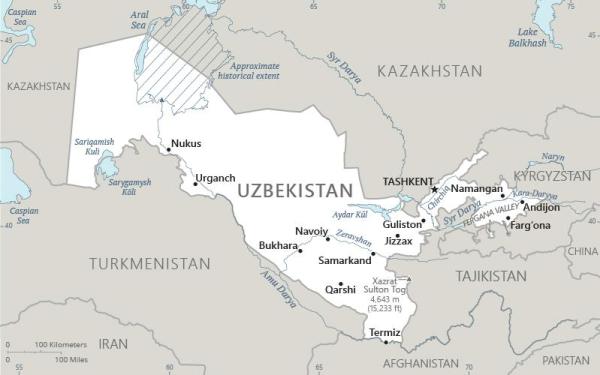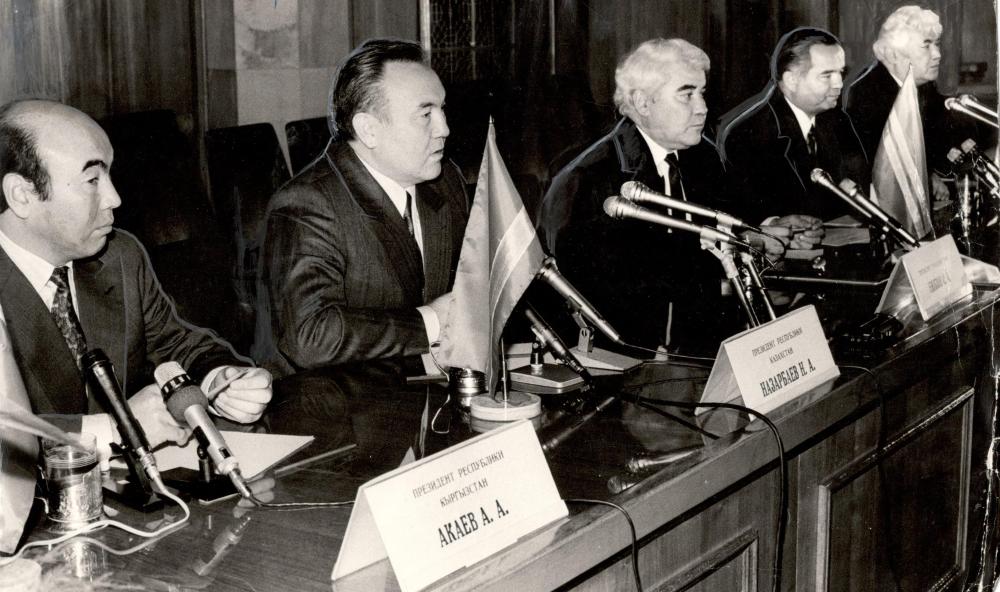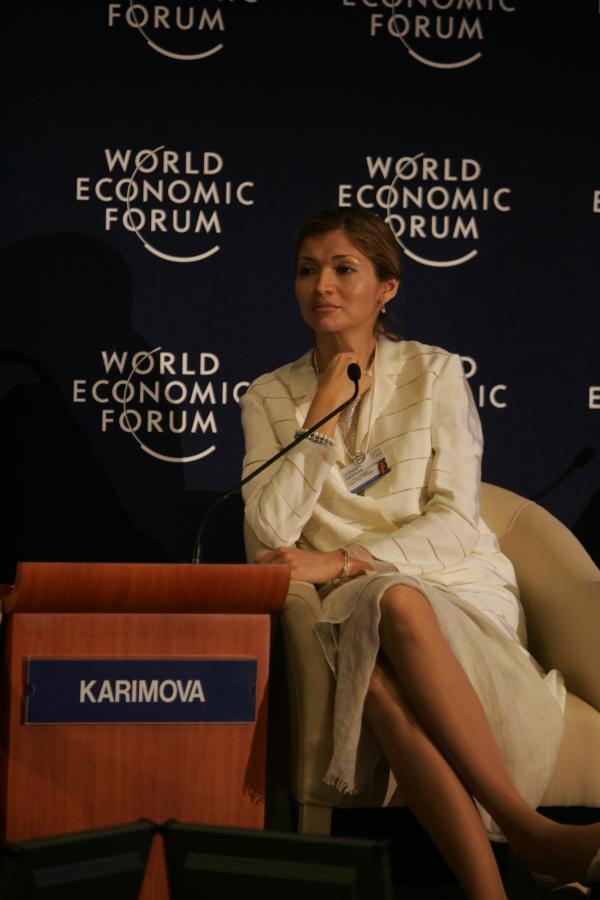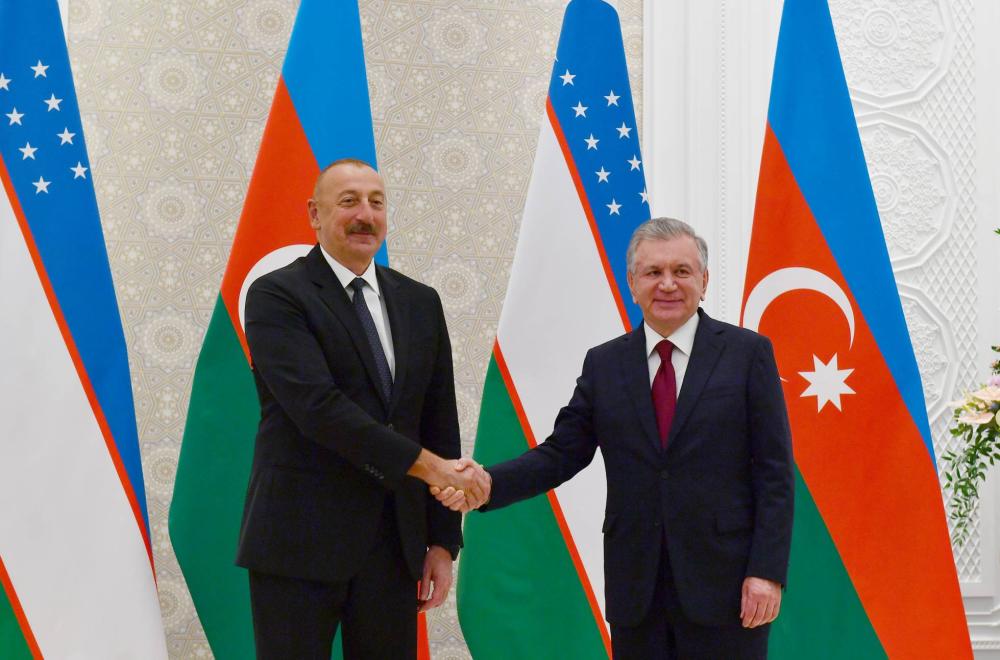Summary

Map of Uzbekistan
Uzbekistan is a nation in Central Asia that borders five countries: Afghanistan, Kazakhstan, Kyrgyzstan, Tajikistan, and Turkmenistan. Formally the country has a mixed presidential-parliamentary system. In practice, it is a consolidated dictatorship. Freedom House consistently ranks Uzbekistan as “Not Free.”
For much of its history, Uzbekistan was inhabited by nomadic peoples and much of its territory was under political control of successive empires. It was also home to trading cities like Bukhara and Samarkand, which were key points on the historic Silk Road. The conqueror Timur (known in Europe as Tamerlane) made Samarkand the capital of a vast empire in the 14th century but it did not last far beyond his death. In the 16th century, Uzbek tribes invaded from the north to establish separate khanates or kingdoms. These were absorbed in the 1800s by the Russian Empire as it expanded south and east.
After a brief period of independence following the 1917 Russian Revolution, Uzbekistan was conquered by the Bolshevik Red Army and formally incorporated into the Union of Soviet Socialist Republics in 1924. As the Soviet Union was collapsing, Uzbekistan again declared independence in 1991. The country was then ruled by an authoritarian dictator, Islam Karimov, who gained absolute control over the government and economy. After his death in 2016, he was succeeded by Prime Minister Shavkat Mirziyoyev, who also acts with few constraints on his power.
After a brief period of independence following the 1917 Russian Revolution, Uzbekistan was conquered by the Bolshevik Red Army and formally incorporated into the Union of Soviet Socialist Republics in 1924.
Uzbekistan is a middle-sized country in area (56th largest in the world) with a population of 36 million people in 2023 (43rd highest in the world). The country does not have substantial oil or gas deposits like its neighbors, Kazakhstan and Turkmenistan. It relies on cotton production as its top export. According to the International Monetary Fund (IMF), Uzbekistan's state-heavy economy ranks 70th in the world in 2024 in projected nominal GDP ($98 billion in total output), but much lower, 138th, in projected per capita income at $2,666 per annum.
History
A Crossroads of Civilizations
Uzbekistan has been a crossroads of many civilizations. Originally inhabited by people speaking a Persian dialect, it was for much of its early history part of the Persian Empire and then conquered by Alexander the Great in the fourth century BCE.
The cities of Bukhara, Khiva, Samarkand and Tashkent later grew prosperous as central links on what was called the Silk Road, a network of trade routes running from China to the Middle East and Europe that first developed in the early centuries CE. Muslim Arabs conquered the region in the eighth century CE. Thereafter it fell under the Persian Samanid Empire, which revived the population’s Persian culture (see also Country Study of Iran). Turkic tribes moving into the area from the north established new regional states in the 11th and 12th centuries.
From Genghis Khan to Timur

An 18th century portrait of Tamerlane by a Dutch artist. Creative Commons. Author: Rijksmuseum.
The territory was conquered by the Mongol leader Genghis Khan in the early 13th century as part of his vast military conquests on the Asian continent. During the fragmentation of the Mongol successor states, Timur, a Turkic Muslim who claimed descent from Genghis Khan, rose to power. Known in Europe as Tamerlane, he built his own empire over 70 years (1336–1405). It extended from the Middle East to border regions of India and China. During Timur’s reign, the capital Samarkand was reborn as a famous center for architecture, Islamic scholarship and trade. Within a century of Timur's death, his empire had broken up amid fighting among rival princes and tribal leaders. But the legacy of Timur and Samarkand’s rise has had lasting influence on Uzbek history and culture.
Turkic Expansion, Russian Domination
In the early 16th century, Turkic-speaking Uzbeks invaded from the north and captured most of current Uzbekistan territory. The Uzbek tribes established small Muslim states based in the great trading cities of Bukhara and Khiva. But overland trade routes declined in importance as European oceanic shipping expanded. The area had continued prosperity into the 19th century, but Uzbek rulers were hampered by conflict with neighboring Persia, raids by nomadic tribes and internecine warfare.
In the 18th and 19th centuries, the Russian empire expanded further into Central Asia and occupied another major city, Tashkent, in 1865. Russia then proceeded to occupy all of the Uzbek emirates and khanates, which the tsars placed under colonial administration or left nominally intact as protectorates. The imperial government encouraged Russian immigration and large-scale growing of cotton, despite its heavy dependence on scarce water resources.
Soviet Rule and Its Consequences
Uzbeks asserted independence after the Russian Revolution of 1917, but by 1920 the Bolshevik Red Army had re-conquered the country and instituted a Soviet government. Uzbekistan was made a Soviet Socialist Republics in the 1924 Constitution. Anti-Soviet guerrilla fighters, dubbed Basmachi (“bandits”) by the Soviets, continued their struggle as late as the 1930s but were finally subdued. Tashkent was named the capital in 1930.
Under Soviet rule, all political rights and civil liberties were denied. The social structures of the country were uprooted and traditional customs and cultural heritage were suppressed.
Under Soviet rule, all political rights and civil liberties were denied. The social structures of the country were uprooted and traditional customs and cultural heritage were suppressed. In the 1936 Constitution, Soviet leader Joseph Stalin redrew the borders of Uzbekistan and the four other Central Asian republics in order to prevent regional unity and perpetuate dependence on centralized authority. Large-scale immigration of ethnic Russians and other ethnic groups was also encouraged. Any leaders suspected of Uzbek nationalism were purged.
Cotton cultivation was greatly expanded at this time, resulting in the massive diversion of river water for irrigation. The previous outlet for the water, the Aral Sea, has since shrunk to a quarter of its former size. The drying of the Aral Sea (with 10 percent its former volume) is among the world's worst man-made environmental disasters.
Uzbekistan regained its independence in 1991 with the collapses of the Soviet Union. Its period of independence is described below.

Basmachi fighters, shown here in negotiations with the Bolshevik Red Army, sought to defend the brief independent republic. They would be relentlessly hunted down as guerilla fighters against Soviet rule into the 1930s. Public Domain.
Constitutional Limits
Uzbekistan has had no significant history of constitutional democracy. For most of its history, the territory fell under various empires. Its initial period of independence following the Russian Revolution in 1917 was short-lived before being re-conquered by the Bolshevik Red Army. It was made a Soviet Republic in the USSR Constitution of 1924 and ruled over as a communist dictatorship.
Uzbekistan again declared independence at the end of August 1991 with the failure of the coup by hardline communist leaders in Moscow against Mikhail Gorbachev. The coup aimed to prevent the Soviet Union’s collapse but instead propelled its disintegration in December 1991.
Under a constitution adopted in 1992, the president's powers are unchecked. Although the charter provides for a separately elected bicameral parliament and independent judiciary, the president holds nearly absolute control over government and much of the economy.
Unlike some post-Soviet republics that gained independence and a measure of democratic governance, the communist-era power structure in Uzbekistan remained largely intact to control the government.
After the Soviet Union formally dissolved in December 1991, Islam Karimov, head of the Communist Party of Uzbekistan and the republic’s sitting president, held a rigged election in which he claimed 88 percent of the vote. Opposition parties that had emerged during the more open period of Soviet rule under Gorbachev, such as the secular Birlik movement and a more religious party, Erk, were banned.
Under a constitution adopted in 1992, the president's powers are unchecked. Although the charter provides for a separately elected bicameral parliament and independent judiciary, the president holds nearly absolute control over both the legislature and the courts, as well as the security forces, government administration and much of the economy. The prime minister and cabinet are the president’s appointed subordinates.
From Karimov to Mirziyoyev
The president's term was initially limited to five years with the possibility of a second term. Staged referendums in 1995 and 2002 lengthened Karimov’s first and second terms. Then, ignoring the constitution’s two-term limit, Karimov ran for a third term in 2007 (claiming again 88 percent support). An amendment to the constitution was passed retroactively to allow the third term. Other amendments extended the term to 2015 and then provided for a fourth term. Karimov declared himself the victor in the 2015 election (this time claiming 91 percent of the vote).
Karimov died soon afterwards, in September 2016, and was succeeded by Shavkat Mirziyoyev, the prime minister since 2003. The new president obtained a full mandate that December against three token candidates in another staged election. The government claimed he received 88.5 percent approval.
No real opposition has been allowed in presidential or parliamentary election contests and no fair conditions exist for opponents to compete for power. Any independent political parties are banned. When an opposition leader in exile announced his intention to run in the 2015 presidential elections, his aged father, living in Uzbekistan, was arrested. After two weeks of being held incommunicado, the father was falsely charged with rape.

Islam Karimov (center) assumed the role of president of newly independent Uzbekistan after serving as the First Secretary of the Uzbekistan Communist Party and as a Politburo member of the Soviet Union. He quickly established an authoritarian dictatorship and ruled as president until his death in 2016. Creative Commons License 4. Photo by EgemenMedia.
General Abuses of Power
After independence, the government promoted Uzbek national identity and encouraged large numbers of ethnic Russians and other non-Uzbeks to leave the country. State authorities imposed strict limits on freedom of speech and the press and exercised control over all major domestic media outlets and newspaper printing facilities. Access to the internet and independent foreign news sources was severely restricted.
In the 1990s, civil society groups arose to promote human rights, small businesses and education, but the regime cracked down harshly on this sector whenever it opposed the regime. New laws made many non-governmental organizations (NGOs) illegal and forced foreign NGOs, such as Human Rights Watch and the Open Society Foundation, to close their offices.
Nearly all human rights activity was quashed as activists were arrested and sentenced to long prison terms on fabricated charges. In September 2013, for example, Bobomorod Rizzakov, a regional leader of Ezgulik, the only registered human rights organization at that time permitted to operate in Uzbekistan, was sentenced to four years imprisonment on false human trafficking charges. He was arrested after criticizing local government officials for corruption.
State authorities imposed strict limits on freedom of speech and the press and exercised control over all major domestic media outlets and newspaper printing facilities. Access to the internet and independent foreign news sources was severely restricted.
International travel was restricted for critics of the regime and even more generally for those employed in professions deemed “sensitive.” Freedom of religion was also restricted. The practice of Islam outside government-controlled mosques and organizations was automatically treated as extremism and associated with terrorism. Thousands of people have been imprisoned under this policy, including those simply involved in independent economic activity.
Extremist organizations do exist and use people’s disaffection with government repression to recruit followers. Some, such as Hizb ut-Tahrir, disavow violent tactics, but militant groups like the Islamic Movement of Uzbekistan (IMU) have carried out terrorist attacks.
The Andijon Massacre
Several bomb blasts in 2004 and 2005 targeting police in Tashkent were officially attributed to the IMU but were more likely staged by government agents. The government used the blasts to carry out widespread arrests aimed at civic and religious activists and small businessmen. Soon afterwards, in May 2005, a small group of gunmen in the city of Andijon organized a prison break to free the local businessmen and took several government employees hostage. Civilians gathered in a public square to air grievances with the government. Security forces arrived at the scene and opened fire on the largely unarmed crowd. Independent observers and human rights organizations claim that as many as 1,000 people were killed, including women and children attempting to flee.
The Andijon Massacre had lasting effect. After the attack, the government continued its crackdown with a series of show trials for the supposed terrorists behind the uprising. The massacre led to deterioration in Uzbekistan's relations with the United States and the European Union, which demanded an independent inquiry. As a result, Karimov strengthened ties with Russia and China and evicted US forces from an air base they had used for operations in Afghanistan.
A Daughter Falls from Favor

Gulnara Karimova, long thought to be the leading candidate to succeed her father, Islam Karimov, as president, fell from favor when large foreign bank accounts were seized by Swiss authorities. Creative Commons License. Photo by Nader Daoud.
In March 2013, Karimov, at 75 years of age, disappeared from public view for eight days, spurring rumors about his succession. Karimov’s eldest daughter, Gulnara Karimova, 40 years old, was the leading candidate until she was accused by Swedish and Swiss authorities of soliciting and obtaining a $300 million payment from the Swedish telecommunications company. The payments were found in family accounts in Swiss banks.
Karimova quickly fell from favor after the bank accounts were frozen pending legal proceedings. The government placed her under house arrest, although this was not a recognized procedure in Uzbek law. In an example of the lack of constitutional limits on power, the legislature amended the constitution to provide ex post facto (after-the-fact or retroactive) authority for indefinite house arrest. Karimov’s perpetuation of his presidency in a staged 2015 election ended temporarily the speculation about his successor.
Current Issues
As noted above, Shavkat Mirziyoyev, the prime minister since 2003, assumed the office of president when Islam Karimov died in September 2016. Under the constitution, a new election was required within three months. The election had similar non-democratic characteristics as previous ones. Mirziyoyev was awarded nearly 90 percent of the vote against five nominal opponents from pro-government parties.
In his first months in office, Mirziyoyev announced a “New Uzbekistan” and adopted some reforms. These included privatizing parts of the economy, releasing some long-held political prisoners and easing controls on the internet to allow some independent media outlets.
Shavkat Mirziyoyev, the prime minister since 2003, assumed the office of president when Islam Karimov died in 2016. . . . [In a special election,] he was awarded nearly 90 percent of the vote against five nominal opponents from pro-government parties. In his first months in office, Mirziyoyev announced a “New Uzbekistan” and adopted some reforms.
The most significant reform was ending onerous state quotas on agricultural collectives. Such quotas, adopted first in the Soviet period, had made forced child labor a prevalent practice in the cotton industry. International campaigns, including by the International Labour Organization, had been organized to end this flagrant abuse of international standards.
The most high-profile action was Mirzoyoyev’s purge of security services and other public offices. Even the head of the feared security services was convicted on a bribery charge. This is a common practice for successors to dictators in order to place persons more loyal to the current leader in positions essential to consolidating and holding on to power.
While Western governments considered some of these reforms positively (especially the end to forced child labor), Mirziyoyev has otherwise governed with no functioning constitutional limits on his power. Uzbekistan remains a harsh dictatorship with few freedoms.
While Western governments considered some of these reforms positively (especially the end to forced child labor), Mirziyoyev has otherwise governed with no functioning constitutional limits on his power. Uzbekistan remains a harsh dictatorship with few freedoms.
All broadcast and print media remain state-controlled, non-governmental organizations operate under tight restrictions and religious freedom continues to be curtailed. Trade unions cannot function independently. The judiciary remains controlled through government appointment. And there is ongoing harassment and repression of civic and human rights activists, independent journalists and political opponents.
The national assembly and senate are tightly controlled through the main Liberal Democratic Party and four pro-government parties, which exist mainly to create an appearance of a multiparty system. Opposition parties continue to be banned or prevented from registration. To further prevent opposition, the parliamentary elections held in 2019-20 no longer allowed independent candidates; all had to be nominated by a registered political party. Predictably, the results re-affirmed dominance by the Liberal Democratic Party and its closest adjunct, the National Revival Democratic Party.
In the regularly scheduled 2021 presidential election, Shavkat Mirziyoyev was again awarded nearly 90 percent voter support for a second term against nominal opposition. Like Karimov, Mirziyoyev then engineered a constitutional referendum to extend presidential terms from five to seven years and to allow him a third and fourth term. The referendum had multiple amendments, including several to ostensibly strengthen or re-affirm due process, human rights and educational opportunity. But the actual purpose was evident. The referendum, held on April 30, 2023, claimed ninety percent approval with 85 percent turnout.

Shavkat Mirziyoyev succeeded Islam Karimov after his death in 2016. He has consolidated full control around his own presidency. In 2022, he met with fellow dictator Ilhan Aliyev, of Azerbaijan. Creative Commons License. Photo from the President’s Information Office of Azerbaijan.
Mirziyoyev immediately called an early election for July 9, 2023 to secure his third term. Again, the government announced overwhelming support against three other candidates. One opposition candidate from a new party (Truth, Progress and Unity) was prevented from running and the party denied registration. (For a fuller picture of Uzbekistan’s current repressive conditions, see “Uzbekistan’s Untouchable President,” in Resources.)
The Uzbek economy is among the worst performing in the world, sharply contrasting from the historical eras when it was the central point on the Silk Road. Corruption is endemic. Most economic and government transactions require bribes. Uzbekistan’s major industry, cotton production, continues to rely on water supplies diverted from the Aral Sea, exacerbating one of the world’s worst man-made environmental disasters.
The content on this page was last updated on .
